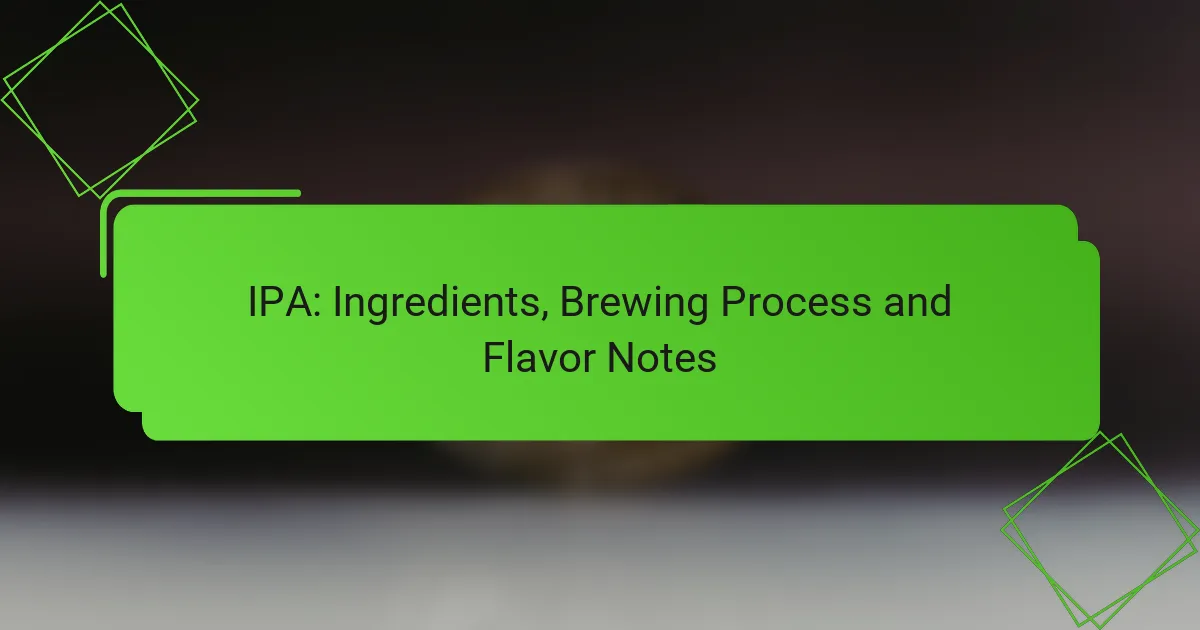Seasonal beer styles offer a delightful way to celebrate the changing weather, with each season bringing its own unique flavors and brewing techniques. In summer, light and refreshing options like wheat beers and pale ales shine, while fall ales embrace rich malty flavors and warming spices. Understanding the key ingredients and flavor profiles of these styles can enhance your brewing experience and elevate your enjoyment of seasonal brews.

What are the best seasonal beer styles for summer?
The best seasonal beer styles for summer are typically light, refreshing, and easy to drink. Popular choices include wheat beers, pale ales, fruit beers, lagers, and saisons, each offering unique flavor profiles that complement warm weather.
Wheat Beer
Wheat beer is known for its light body and refreshing taste, making it a perfect summer choice. It often features a hazy appearance and a slightly fruity or spicy flavor profile due to the use of wheat and specific yeast strains.
When brewing wheat beer, consider using a mix of malted wheat and barley for balance. Aim for a low to moderate alcohol content, typically around 4-5.5% ABV, to keep it sessionable during hot days.
Pale Ale
Pale ales are versatile and can range from hoppy to malty, but summer versions often lean towards a more balanced profile with citrusy hop notes. These beers generally have a moderate alcohol content, making them enjoyable for casual sipping.
For a summer pale ale, use hops like Cascade or Citra to impart bright, fruity flavors. Keep the bitterness in check to ensure a smooth finish that pairs well with grilled foods and outdoor activities.
Fruit Beer
Fruit beers are a delightful way to incorporate seasonal fruits into brewing, enhancing the beer’s flavor and aroma. Common fruits used include berries, citrus, and stone fruits, which add a refreshing twist.
When brewing fruit beer, consider adding fruit during fermentation to achieve a natural flavor. Aim for a balance between the beer’s base style and the fruit’s sweetness, typically keeping the ABV around 4-6% for a light, enjoyable drink.
Lager
Lagers are crisp and clean, making them a staple for summer drinking. They are fermented at cooler temperatures, resulting in a smooth finish that is highly refreshing on warm days.
For summer lagers, focus on using light malts and noble hops to create a balanced flavor. A classic example is a pilsner, which typically has an ABV of around 4-5% and pairs well with light summer dishes.
Saison
Saison is a farmhouse ale that offers a complex flavor profile, often featuring fruity, spicy, and earthy notes. This style is highly carbonated and can be quite refreshing, making it suitable for summer enjoyment.
When brewing a saison, use a variety of grains and consider adding spices or herbs for additional complexity. The ABV can vary widely, but a range of 5-7% is common, allowing for a flavorful yet sessionable experience.

How to brew a refreshing summer wheat beer?
To brew a refreshing summer wheat beer, focus on using a high proportion of wheat malt, which contributes to a light and crisp flavor. Incorporating fruity hops and a clean fermentation profile will enhance the beer’s refreshing qualities, making it perfect for warm weather.
Ingredients: Wheat, Hops, Yeast
The primary ingredient in a summer wheat beer is wheat malt, typically comprising 50-70% of the grain bill. This malt provides a smooth mouthfeel and a hazy appearance, which are characteristic of this style. Pair the wheat with a light base malt, such as Pilsner or Pale malt, to balance the flavor.
Hops play a crucial role in adding aroma and flavor. Choose hops with fruity or floral notes, such as Citra or Saaz, and use them sparingly to avoid overpowering the wheat character. For yeast, select a strain that ferments cleanly, like a German Hefeweizen yeast, which can impart subtle banana and clove notes without being too dominant.
Brewing Steps: Mashing, Fermentation
Start the brewing process with mashing, aiming for a temperature of around 65-70°C (149-158°F) for about 60 minutes. This temperature range helps convert the starches in the wheat and malt into sugars, resulting in a fermentable wort. After mashing, sparge with water to collect the wort, ensuring you extract as much sugar as possible.
During fermentation, pitch the yeast at around 18-20°C (64-68°F) to promote a clean fermentation. Monitor the fermentation process, which typically lasts one to two weeks. Once fermentation is complete, consider a short conditioning period to allow flavors to meld before bottling or kegging. Aim for a carbonation level of 2.5-3 volumes to enhance the refreshing qualities of the beer.

What flavor profiles should I expect from fall ales?
Fall ales typically feature rich, malty flavors with a warming spice character. These beers often evoke the essence of autumn, combining sweetness and complexity to create a comforting drinking experience.
Malty and Spicy
Fall ales are known for their prominent malt profiles, which can range from toasty and nutty to caramel-like sweetness. The malt backbone provides a solid foundation for the beer, enhancing its body and mouthfeel.
Spices such as cinnamon, nutmeg, and clove are commonly added to fall ales, contributing to their seasonal appeal. These spices can complement the maltiness, creating a balanced flavor that is both inviting and satisfying.
Notes of Pumpkin and Caramel
Many fall ales incorporate pumpkin or pumpkin pie spices, which add a unique twist to the traditional malt profile. The pumpkin contributes a subtle sweetness and earthy flavor, enhancing the overall complexity of the beer.
Caramel notes are often present in fall ales, resulting from the use of caramel malts during brewing. This sweetness can help to balance out the bitterness from hops, creating a harmonious flavor experience that is perfect for the cooler months.

How to choose ingredients for winter stouts?
Choosing ingredients for winter stouts involves selecting rich, dark malts and complementary flavors that enhance the beer’s warmth and complexity. Focus on ingredients that provide depth and a comforting profile to match the season.
Dark Malts
Dark malts are essential for creating the robust flavor and color characteristic of winter stouts. Look for options like roasted barley, chocolate malt, and black malt, which contribute to the beer’s deep, rich hues and complex flavors.
When selecting dark malts, aim for a balance between bitterness and sweetness. Typically, using around 10-20% of the total grain bill for dark malts can yield a well-rounded stout. Avoid overusing them, as this can lead to excessive bitterness.
Chocolate and Coffee Flavors
Incorporating chocolate and coffee flavors can elevate the sensory experience of winter stouts. Consider adding cocoa nibs or coffee beans during fermentation to impart rich, aromatic notes that complement the malt profile.
For a balanced flavor, use about 0.5-1 pound of cocoa nibs or coffee per 5 gallons of beer. Experiment with different varieties to find the right intensity, but be cautious not to overpower the stout’s base flavors. A common pitfall is adding too much, which can lead to an unbalanced brew.

What are the key characteristics of spring IPAs?
Spring IPAs are characterized by their vibrant hop profiles, which often include citrus and floral notes, making them refreshing choices for the season. These beers typically have a lighter body and a crisp finish, appealing to those looking for a flavorful yet easy-drinking option as the weather warms up.
Citrus and Floral Aromas
The aroma of spring IPAs is dominated by citrus and floral notes, which are achieved through the use of specific hop varieties. Common hops like Citra, Mosaic, and Amarillo impart bright, zesty aromas reminiscent of oranges, lemons, and various flowers.
When brewing, consider adding hops late in the boil or during fermentation (dry hopping) to maximize these aromatic qualities. This technique enhances the beer’s bouquet without significantly increasing bitterness, allowing the fresh flavors to shine through.
Light Body and Crisp Finish
Spring IPAs typically feature a light to medium body, which contributes to their drinkability. This lighter mouthfeel is often achieved by using pale malts and limiting darker grains, allowing the hop flavors to be the star of the show.
A crisp finish is essential for a refreshing experience, often complemented by a moderate carbonation level. Aim for a balance where the hop bitterness is present but not overpowering, usually in the range of 30 to 50 IBU (International Bitterness Units), ensuring a clean and satisfying sip.

What brewing techniques enhance seasonal flavors?
Brewing techniques that enhance seasonal flavors include methods like dry hopping and cold brewing, which can significantly influence the aroma and taste profile of the beer. By carefully selecting these techniques, brewers can create distinctive seasonal brews that resonate with the characteristics of each season.
Dry Hopping
Dry hopping involves adding hops to the beer after the boiling process, allowing for a more pronounced aroma without imparting excessive bitterness. This technique is particularly effective for creating fresh, floral, or fruity notes that align well with seasonal styles, such as IPAs in the summer or pale ales in the spring.
When dry hopping, consider the timing and quantity of hops. Adding hops during fermentation can yield different flavor profiles than adding them just before bottling. A common range is to use between 0.5 to 2 ounces of hops per gallon, depending on the desired intensity.
To avoid common pitfalls, ensure that your fermentation temperature is controlled, as higher temperatures can lead to off-flavors. Experiment with different hop varieties to find the perfect match for your seasonal brew.
Cold Brewing
Cold brewing is a method typically associated with coffee but can also be applied to beer, particularly stouts and porters, to create a smooth, rich flavor. This technique involves steeping the coffee or grains in cold water for an extended period, usually 12 to 24 hours, resulting in a less acidic and more mellow profile.
For beer, cold brewing can enhance the sweetness and reduce bitterness, making it ideal for winter seasonal styles. Use a coarser grind for the grains and maintain a cold temperature throughout the brewing process to achieve the best results.
Keep in mind that cold brewing requires patience, as the extended steeping time can be a barrier for some brewers. However, the resulting flavors can be well worth the wait, providing a unique twist to traditional seasonal offerings.

How do local ingredients impact seasonal beer styles?
Local ingredients significantly influence seasonal beer styles by affecting flavor profiles, aromas, and overall character. Using regional grains, hops, and adjuncts can enhance the uniqueness of a brew, aligning it with local tastes and traditions.
Flavor profiles influenced by local ingredients
Local ingredients can create distinct flavor profiles that reflect the terroir of the region. For example, using locally sourced hops may impart unique floral or citrus notes that differ from those grown elsewhere. Additionally, local grains can contribute to varying malt sweetness or body, enhancing the beer’s overall complexity.
Common local ingredients for seasonal beers
Seasonal beers often incorporate ingredients that are in season or native to the brewing region. Common examples include fresh fruits like cherries or peaches in summer ales and spices such as cinnamon or nutmeg in winter brews. Utilizing these ingredients not only supports local agriculture but also creates a sense of place in the beer.
Considerations for sourcing local ingredients
When sourcing local ingredients, brewers should consider availability, quality, and cost. Seasonal fluctuations can affect ingredient supply, so establishing relationships with local farmers or suppliers is beneficial. Additionally, brewers should be mindful of the potential for variability in flavor and quality when using fresh, local ingredients, as this can impact the final product.



